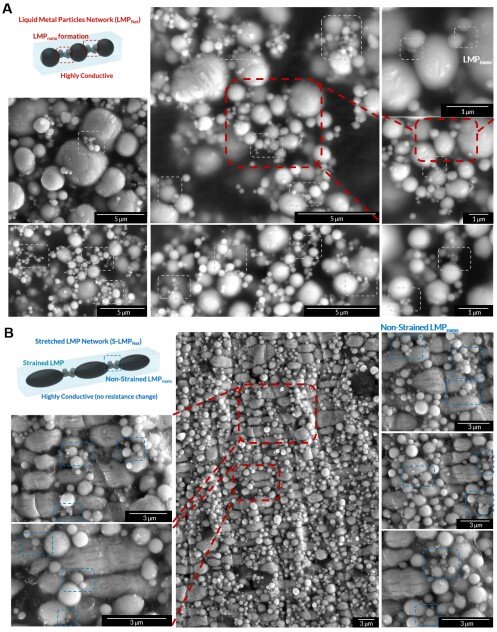博文
利用声场在聚合物内部创建液态金属导电网络
 精选
精选
||
利用声场在聚合物内部创建液态金属导电网络
诸平
SEM images of LMPNet and their deformations under stretching. (A) SEM images of LMPNet formed by the acoustic wave. White blocks indicate the newly synthesized LMPnano between large size (2~3 μm) LMPs. (B) SEM images of 100% stretched LMPNet. Large size LMPs are deformed by the strain and newly synthesized LMPnano are intact, so the percolation path of LMPNet is maintained. Credit: Science (2022). DOI: 10.1126/science.abo6631
据物理学家组织网(Phys.org)2022年11月11日报道,韩国科学技术院(Korea Advanced Institute of Science and Technology简称KAIST)的一组研究人员与韩国基础科学研究所(Institute for Basic Science简称IBS),的一位同事合作,发现了一种在聚合物内部创建电子网络的简便方法。他们用声场把液态金属点连接起来,在聚合物内部创建了液态金属导电网络(Using an acoustic field to create a liquid metal conductive network inside a polymer)。
相关研究结果于2022年11月11日已经在《科学》(Science)杂志网站发表——Wonbeom Lee, Hyunjun Kim, Inho Kang, Hongjun Park, Jiyoung Jung, Haeseung Lee, Hyunchang Park, Ji Su Park, Jong Min Yuk, Seunghwa Ryu, Jae-Woong Jeong, Jiheong Kang. Universal assembly of liquid metal particles in polymers enables elastic printed circuit board. Science, 10 Nov 2022, 378 (6620): 637-641. DOI: 10.1126/science.abo6631. https://www.science.org/doi/10.1126/science.abo6631
在此论文中,该团队描述了他们的技术及其可能的用途。澳大利亚昆士兰大学澳大利亚生物工程和纳米技术研究所(Australian Institute for Bioengineering and Nanotechnology, The University of Queensland, Brisbane, QLD, Australia)的乔瑞瑞(Ruirui Qiao音译) 和英国伯明翰大学电子、电气与系统工程系(Department of Electronic, Electrical and Systems Engineering, University of Birmingham, Birmingham, UK)的唐诗阳(Shi-yang Tang音译)在《科学》(Science)杂志网站同日同期发表了题为“将液态金属与声音连接起来”(Connecting liquid metals with sound)的文章,概述了该团队的研究成果。详见Ruirui Qiao, Shi-Yang Tang. Connecting liquid metals with sound. Science, 10 Nov 2022, 378 (6620): 594-595. DOI: 10.1126/science.ade1813. https://www.science.org/doi/10.1126/science.ade1813
随着便携式设备(portable devices)成为主流,消费者对易用性的要求越来越高。其中一个要求是设备可弯曲和/或可伸展。据信,这样的改变会让它们更容易、更自然地放在口袋或钱包里,而且握在手中也会更舒服。
但是,电子器件弯曲或拉伸是很困难的,因为电子器件内部的电路也需要弯曲或拉伸。这很有挑战性,因为可弯曲的材料通常不能很好地导电。为了解决这个问题,研究人员一直在研究液态金属(liquid metals)。
但这也带来了问题。这些金属通常与氧反应,导致形成不导电的氧化膜(oxide skin)。在这项新的研究中,研究人员找到了一种解决这一问题的方法,即利用声场在液态金属液滴之间形成桥梁,然后将其嵌入聚合物中。
为了使用他们的技术制造出一个电子网络,研究人员在一个表面上打印了镓基液态金属液滴(gallium-based liquid metal drops),同时施加了声场。声场产生的振动导致了微小液滴的形成,在较大液滴之间形成了一座桥梁,从而形成了导电网络,使电路得以构建。在形成氧化膜之后,将液态金属网络嵌入可弯曲/可拉伸聚合物内部。
因此,电路既可以弯曲又可以拉伸。测试表明,在拉力作用下,单个的液态金属珠子会伸展成椭圆形,从而使电路能够继续导电。
此项研究得到了韩国国家研究基金会的基础科学研究计划(Basic Science Research Program through the National Research Foundation of Korea: 2021R1C1C1011116)和韩国国家研究基金会的国家研发项目(National R&D Program through the National Research Foundation of Korea: 2021M3H4A1A03048648)的资助。
上述介绍,仅供参考。欲了解更多信息,敬请注意浏览原文或者相关报道。
Liquid metal ink liberates form
Acoustic patterning and fabrication (DOI: 10.1126/science.abo663)
Liquid metals can be used to form the conductive pathways in a flexible matrix, but this approach requires patterning of the soft material and sintering of the liquid metal using lasers or mechanical force. Lee et al. used acoustic fields to assemble a network of liquid metal particles inside a polymer matrix for the fabrication of elastic printed circuit boards (see the Perspective by Qiao and Tang). Their devices showed high conductivity, high stretchability, strong adhesiveness, and negligibly small changes in electrical resistance during stretching. Because the acoustic field strategy is universal, the authors synthesized hydrogels, a self-healing elastomer, and photoresists by combining various polymers with liquid metals. —MSL
Abstract (DOI: 10.1126/science.abo663)
An elastic printed circuit board (E-PCB) is a conductive framework used for the facile assembly of system-level stretchable electronics. E-PCBs require elastic conductors that have high conductivity, high stretchability, tough adhesion to various components, and imperceptible resistance changes even under large strain. We present a liquid metal particle network (LMPNet) assembled by applying an acoustic field to a solid-state insulating liquid metal particle composite as the elastic conductor. The LMPNet conductor satisfies all the aforementioned requirements and enables the fabrication of a multilayered high-density E-PCB, in which numerous electronic components are intimately integrated to create highly stretchable skin electronics. Furthermore, we could generate the LMPNet in various polymer matrices, including hydrogels, self-healing elastomers, and photoresists, thus showing their potential for use in soft electronics.
Abstract (DOI: 10.1126/science.ade1813)
Gallium (Ga) is a silver-blue metal that melts at 29.8 ℃ and is useful for creating alloys with a wide range of properties. For example, an alloy of Ga and indium (In) with roughly a 3-to-1 ratio has a melting point of just 15.7 ℃, although In has a melting point of ~157 ℃. Ga alloys that are liquid at room temperature, called Ga-based liquid metals (GaLMs), generally have low toxicity and high electrical and thermal conductivities1. Because of these properties, GaLM-polymer composite materials have been considered for creating electronic components in stretchable devices, such as those used in biomedical and biosensing applications. However, an approach to reliably fabricate stretchable conductive circuits using GaLM-polymer composites has remained elusive. On page 637 of this issue, Lee et al2 report using acoustic waves to manipulate and create a conductive network of GaLM microdroplets embedded in polymer.
https://blog.sciencenet.cn/blog-212210-1364027.html
上一篇:2022年高被引研究人员名单中若干亮点
下一篇:Unimon: 一种促进量子计算机应用的新量子比特
